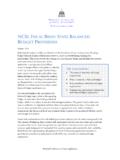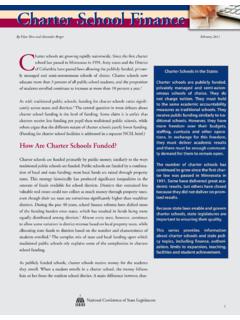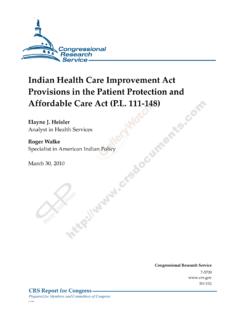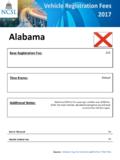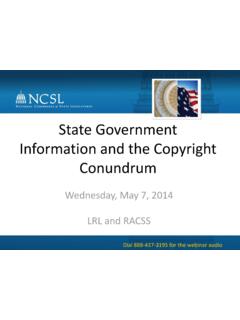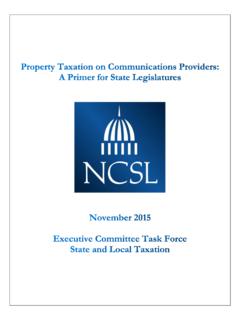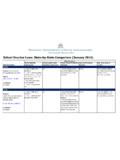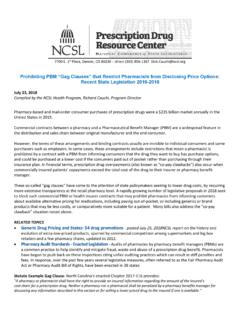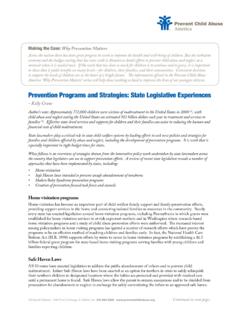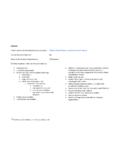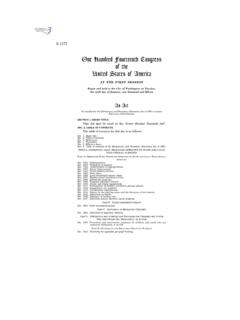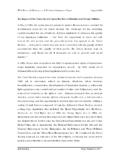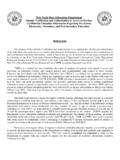Transcription of SUMMARY OF THE EVERY STUDENT SUCCEEDS …
1 SUMMARY OF THE EVERY STUDENT SUCCEEDS ACT, LEGISLATION. REAUTHORIZING THE elementary AND secondary education ACT. Legislative History A conference committee met on November 18 and 19 to resolve the differences between 5, the STUDENT Success Act, and S. 1177, the EVERY Child Achieves Act, which passed their respective chambers in July, and voted to adopt the conference framework by a vote of 38-1. Legislative language was completed over Thanksgiving. The conference report then passed the House on December 2 by a vote of 359-64, and the Senate on December 9 by a vote 85-12. The bill's title is the EVERY STUDENT SUCCEEDS Act, abbreviated in the SUMMARY as ESSA. It reauthorizes programs in the elementary and secondary education Act for four years.
2 Major Provisions Transition/Effective Dates For noncompetitive programs the effective date is July 1, 2016, and most competitive programs are in effect October 1, 2016. The Secretary of education ( Secretary ) will takes steps to provide an orderly transition to and implementation of programs authorized by the Act. Certain waivers are terminated as of August 1, 2016, specifically those under Section 9401 of No Child Left Behind, as first introduced in a letter to chief state school officers on September 23, 2011. The transition to new state plans will begin in the 2016-2017 school year, with full implementation occurring in the 2017-2018. school year. Title I. Part A. Grants to LEAs are authorized in the amounts below: FY 2017 $15,012,317,605.
3 FY 2018 $15,457,459,042. FY 2019 $15,897,371,442. FY 2020 $16,182,344,591. 1. Other grants authorized in Title 1: State assessments $378,000,000 for FYs 2017 through FY 2020. education of Migratory Children $374,751,000 for FYs 2017 through 2020. Neglected, Delinquent, or At-Risk Children and Youth. $47,614,000 for FYs 2017 through 2020. School Improvement Grants School Improvement Grants in their current form are ended. Instead, to carry out statewide system of technical assistance and support for local educational agencies, each state shall reserve either seven percent of Title I Part A or the amount the state had reserved for school improvement in 2016 and the amount it received, whichever is greater. Not less than 95 percent of the amount would go in grants to LEAs on formula or competitive basis for schools implementing comprehensive support and improvement activities or targeted support and improvement activities or the SEA may directly provide those activities.
4 These would be four year grants. State plans The State education Agency (SEA) must submit a Title I plan to the Department of education that is developed with timely and meaningful consultation with Governors, members of the state legislature, and state board of education (if the state has such a board). The list also includes other entities including local education agencies, Indian tribes, teachers and principals and parents, among others. This represents a real corrective from the original ESEA which focused solely on the state education agency. The language was a top priority in NCSL lobbying on reauthorization. Plans must ensure coordination between programs in the following laws: IDEA, the Rehabilitation Act, Perkins Career and Technical education Act, WIOA, CCDBG, education Sciences Reform Act, education Technical Assistance Act, NAEP, McKinney-Vento, Adult education and Family Literacy Act.
5 Standards Each state's plan shall provide an assurance that the state has adopted challenging academic content standards and aligned academic achievement standards ( challenging state academic standards ) that include not less than three levels of achievement. Standards must apply to all public schools and public school students in a state. States are required to have academic standards for math, reading or language arts, and science and may have them for any other subject determined by the state. Standards must be aligned with entrance requirements for credit-bearing coursework at state higher education institutions and with relevant state career and technical education standards. States are allowed to adopt alternate academic achievement standards for students with the most significant disabilities, provided those standards align with state academic standards and promote access to the general education curriculum consistent with IDEA, and are aligned to ensure that a STUDENT who meets the alternative standards is on track to pursue postsecondary education .
6 States must also show in their plan that they have adopted English language proficiency standards. English language proficiency standards must be derived from four domains (speaking, listening, reading and writing), address the different proficiency levels of English learners, and be aligned with the challenging state academic standards. 2. Academic Assessments States are required to implement a set of high-quality STUDENT academic assessments in math, reading/language arts, and science, and may implement assessments in other subjects. These assessments (with exceptions regarding alternative assessments for certain students ) must be administered to all elementary and secondary students and must measure the achievement of all students .
7 Assessments must be aligned with challenging state academic standards. The bill keeps the current schedule of federally required statewide assessments. Math and reading/language arts have to be assessed yearly in grades three through eight, and once in grades nine through 12. Science must be assessed at least once in grades three through five, grades six through nine, and once in grades 10 through 12. States may assess other subjects. These assessments must involve multiple measures of STUDENT achievement, including measures that assess higher-order thinking skills and understanding, which may include measures of STUDENT growth and may be partially delivered in the form of portfolios, projects or extended performance tasks. They must provide appropriate accommodations for children with disabilities.
8 The assessments can be administered through a single summative assessment or through multiple assessments during the course of the academic year. Results must be disaggregated with each state, local education agency, and school by: Racial and ethnic group;. Economically disadvantaged students compared to students who are not economically disadvantaged;. Children with disabilities as compared to children without disabilities;. English proficiency status;. Gender; and Migrant status Alternate assessments are to be aligned with alternative academic standards and achievement goals. Only one percent of the total number of all students in the state can be assessed using these alternate assessments. LEAs may administered a nationally-recognized high school academic assessment approved by the state in place of a required statewide assessment.
9 NOTE: other provisions regarding assessments are contained in Part B of Title I of the bill, including new flexibility to develop innovative assessments, and are described below. ESSA contains a parental rights statement that ESSA does not preempt a state or local law regarding the decision of a parent to not have their child participate in the assessments. However, that child is still counted against the 95% participation rate requirement. Subject to federal or state requirements related to assessments, evaluations, and accommodations, states may set a target limit on the number on the aggregate amount of time devoted to assessments in each grade, expressed as a percentage of instructional hours. Statewide Accountability System 3.
10 Each state must have a statewide accountability system that is based on the challenging state academic standards for reading/language arts and math to improve STUDENT academic achievement and school success. States shall: Establish ambitious state-designed long-term goals for all students and each subgroup of students in the state for improved: o Academic achievement as measured by proficiency on the annual assessments o High school graduation rates including the four-year adjusted cohort graduation rate and at the state's discretion the extended-year adjusted cohort graduation rate o Percent of English learners making progress in achieving English language proficiency The indicators of the system, for all students and separately for each subgroup o Academic achievement as measured by proficiency on annual assessments o Another indicator of academic achievement o For high schools, a measure of the graduation rate.
